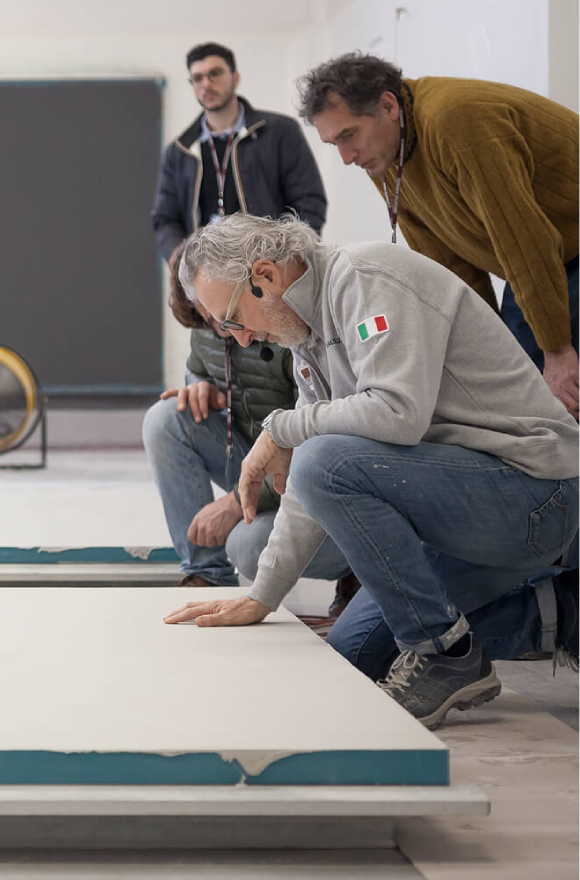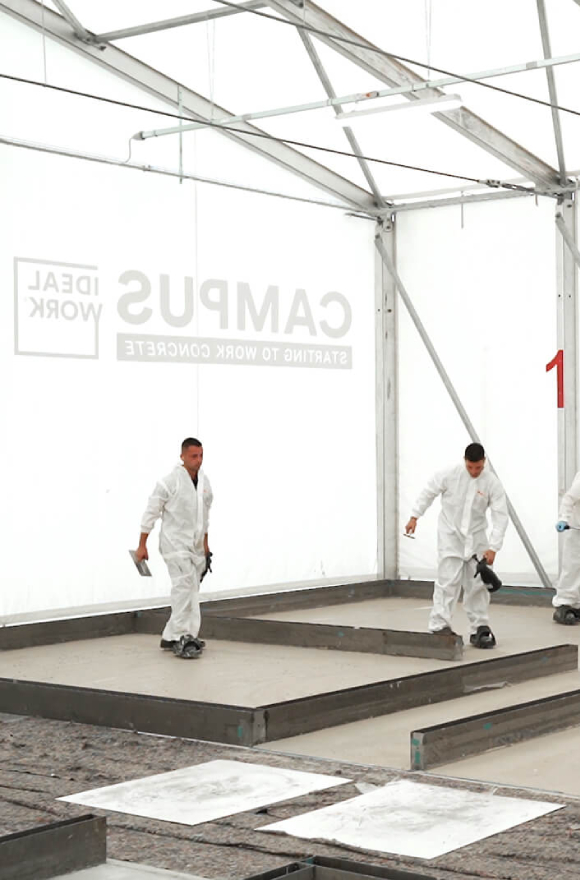Common errors in laying microcement
At Ideal Work, we know how extraordinary microcement is. Versatile, durable, seamless, suitable for both horizontal and vertical surfaces, interiors and exteriors — it’s no surprise that microcement is now one of the most sought-after solutions by architects, interior designers, and clients alike.
Behind its apparent simplicity lies a complex and delicate system that requires specific expertise, the utmost attention to detail, and a deep understanding of both materials and application cycles.
Yet there are installers who apply microcement without the necessary skills. In this article, we’ll look at the most common mistakes made during microcement application, highlighting technical and design-related issues that can compromise the final result. It’s not enough to know how to “spread” a product: one must understand the dynamics of the substrate, the interaction between coatings, and the environmental conditions in which the material is applied.

Underestimating substrate preparation
The application of microcement starts long before the material is laid. Improper or insufficient surface preparation is one of the most common errors. The substrate must be structurally sound, cohesive, dry, free of contaminants (oils, dust, glue or wax residues, etc.), and properly levelled.
A frequent mistake is applying microcement to substrates with excessive residual moisture (for example, uncured screeds), which leads to efflorescence, detachment, or capillary rise. In other cases, existing cracks, ignored expansion joints, or irregular surfaces are overlooked, all of which undermine both the continuity and durability of the finish.
Each type of substrate requires a specific assessment and, when necessary, preparatory treatments (such as primers, fibreglass mesh, epoxy or cementitious levelling compounds, consolidants, etc.). Skipping this stage compromises the entire application cycle and the project itself.
Improvising the application cycle
There is no single microcement. Different formulations exist (cement-based, resin hybrids, two-component or single-component systems), each with its own specific application cycle. A common mistake is to use a “standard” or — worse — improvised method without considering the nature of the substrate, environmental conditions, expected foot traffic, or end use.
For example, a cycle intended for a humid environment like a bathroom must include effective waterproofing and proper sealing, while a high-traffic floor needs more resistant top layers protected with polyurethane or bi-component coatings.
Applying microcement “by heart” — perhaps based on experience with other materials or empirical habits — is one of the main causes of post-application issues, such as cracking, delamination, undesirable colour shifts, loss of water repellence, or premature aesthetic damage.
Mistakes in product mixing
Microcement is a technical material, and every component (base, pigments, resin, hardener, etc.) must be mixed in precise ratios. Mistakes in weighing, mixing sequence, or using inappropriate tools can lead to defects in homogeneity, poor workability, clumps, or visible colour variations.
A classic error is adding water to “loosen up” the mix, which weakens the material’s strength and cohesion. Another frequent issue is mixing too large a quantity, which begins to harden before it can be applied, leading to uneven trowel marks or too-short working times.
Mixing — often treated as a secondary step — is in fact crucial, and must be carried out with precision, consistency, and under controlled environmental conditions.
Uneven application or incorrect layering
Microcement is applied in thin coats — each layer skimmed to zero — to reach a final thickness typically between 1 and 3 mm.
Each layer must be uniform: uneven thickness causes chromatic inconsistencies, areas of high porosity, or spots that are more vulnerable to wear.
A common mistake is to apply each coat unevenly, often due to inconsistent pressure or incorrect trowel angle (ideally around 45°). Drying times must also be respected, and sanding is essential to achieve the desired texture.
The application method has a major aesthetic impact. Trowel movements must be consistent and not overly broad. A disorganised application — irregular strokes or visible overlaps — will leave irreversible marks that diminish the final look. This is especially true for darker colours, where every contrast is amplified.
Insufficient or inappropriate protective finish
The surface protection cycle is the last — but not least — step. Varnishes, waxes, sealers: choosing the right protective system is essential for microcement to resist scratches, stains, water, chemicals, and UV rays.
Many installers underestimate this phase, applying low-quality or unsuitable products for the type of usage. Others apply the protection too early, before the microcement has fully dried, which traps moisture or results in dull, poorly adhered films.
Effective protection requires proper curing times, clean and ventilated environments, the right tools, and high-quality products specifically formulated for the chosen microcement.

Lack of informed maintenance
Microcement is not “maintenance-free”: it requires minimal but regular care. One of the most common mistakes is failing to educate the end user on proper cleaning and maintenance, leading them to use acidic, abrasive, or bleach-based products that quickly break down the surface protection and damage the finish.
Even rubber-backed anti-slip mats or prolonged standing water can cause marks, dull spots, or permanent stains.
Client education is part and parcel of a skilled installer’s job: providing a care guide, recommending compatible products, and ideally offering professional maintenance services is a mark of professionalism and expertise.
You can’t fake being an installer
There is no room for approximation in microcement application. Behind every perfectly smooth, cohesive, and compact surface lies meticulous work, based on informed choices, the right materials, and precise technique. Installation mistakes — often invisible at first — eventually emerge, when fixing them may require demolishing and starting over.
For this reason, ongoing training, a thorough understanding of application systems, and collaboration with trusted suppliers are essential for anyone wishing to be a serious and competent professional in the microcement world. Those who truly master the material don’t just avoid mistakes — they transform every surface into a perfect balance of technique and beauty.
By attending our professional training courses for installers, you’ll gain all the skills you need to deliver excellent results without errors. Our continuous support, from project start to finish, and our dedicated app for professional installers, will always be by your side — helping you work at your best.